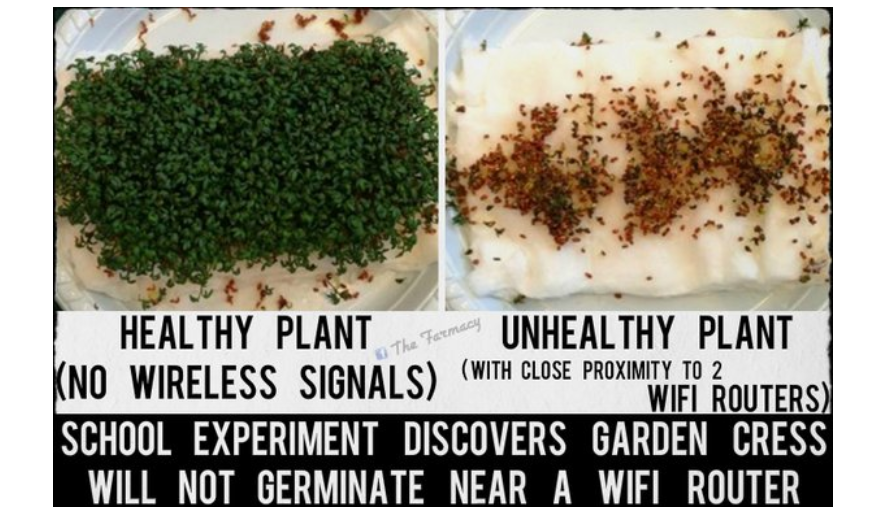What do cell phones, cell towers, Wi-Fi, Smart Meters and other “smart” devices all have in common?
They emit radiation, which no one wants to take seriously as having adverse health effects on humans. Medically, the adverse effects are called “Non-thermal health effects.”
In 2013, a ninth grade experiment for a national science fair found remarkable proof of radiation damage from Wi-Fi routers that was replicated by a peer review study. Wow! So, what did both experiments show? Garden cress seeds placed near Wi-Fi routers failed to germinate.
Five Danish schoolgirls proved what apparently no one in the microwave industry wanted to. Wi-Fi radiation causes adverse effects to any life forms, which, in their experiment, were garden cress seeds. The young ladies placed the seeds near two Wi-Fi routers, waited and took photographs for twelve days. The results—failure of seeds to germinate—can be seen in the above photographs.
So, what does that experiment portend for humans? That similar effect(s) can occur from cell towers too. Two researchers, “Drs. Cammaerts and Johansson conducted a partial replication of the original Danish student study using cell towers instead of WiFi routers as the source of wireless radiation. They found that cress seeds located 200 meters from two cell towers failed to germinate.” [1] What did they conclude from their findings? “Wireless technology may effectively and seriously impact nature and should urgently be used much more cautiously.”
That wireless technology may effectively and seriously impact nature and should be used much more cautiously challenges why Wi-Fi routers are standard technology in USA schools; why Smart Meters for electric, natural gas, and water utility companies are mandated and retrofitted on to every dwelling; and why cell towers [2], especially “stingrays” [3], litter the landscape like mushrooms after a spring rain, while radiation-emitting computers and smart phones are like appendages dangling from almost everyone’s personage. All those technologies emit electromagnetic frequencies in various ranges with adverse consequences for the environment, plant life (as we’ve seen with the cress seeds), animals and humans.
Here are some studies that corroborate my last statement:
Man-made electromagnetic waves have actually largely been shown to have adverse effects on living organisms. They affect, for instance,
- mammals (Adang et al., 2006; Benlaidi & Kharroussi, 2011),
- birds (Everaert & Bauwens, 2007),
- amphibians (Balmori, 2006),
- bees (Kimmel et al., 2007, Sharma & Kumar, 2010; Favre, 2011),
- ants (Cammaerts et al., 2012, 2013),
- fruit flies (Panagopoulos et al., 2004; Panagopoulos, 2012), and even
- protozoa (Cammaerts et al., 2011).
- In fact, they act firstly and essentially on the cellular membrane and so affect any living organism (Cammaerts et al., 2011). Such waves have also been shown to impact plants (Roux et al., 2008; Haggerty, 2010), at physiological and ecological levels. [1] [CJF emphasis added}
Any microwave technology device that transmits and receives information, signals, data, or voice messages emits EMFs / RFs known as non-ionizing radiation that produce Non-thermal adverse health effects recognized by the American Academy of Environmental Medicine here and which vested microwave technology interests pooh-pooh. They claim the only adverse health problem can be heated skin, and none of their devices cause that. However, that ‘science’ is based on early radar tests done in the 1950s and 1960s; it’s now 2016.
Now, I have a bridge on the moon I’d like to sell. Who wants to buy it? No one, I’m certain, believes that’s a factual statement. Then, why oh why, do consumers believe microwave technologies are not harmful? I remember when cigarettes were smoked by doctors, and Camels was their favorite brand.
When will consumers get out from under the notion that if it’s on the market, there’s nothing wrong with it, it’s been tested accurately for safety, and we must have every updated version of the product?

